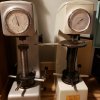- Joined
- Apr 3, 2009
- Messages
- 3,268
Scour local craigslist, facebook marketplace and even Ebay. I found my Wilson M-51ST portable tester on Ebay. Excellent condition and only $425 shipped! Deals for them are out there just gotta be patient and ready to jump when one pops up.I use a tester at work. So, it's pretty impractical for me to do every blade. BUT, I do test several of each heat number, and buy the biggest piece and as much as that heat that I can afford. So it's pretty easy to test half of the knives out of each heat.
I'd simply LOVE to have one at home for testing HT schedules. It's a pain to start a new steel or batch without it. I'm open to suggestions for testers. The Grizzly is the cheapest I've found.



